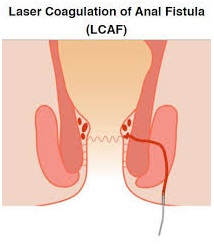Laser Surgery for an complex anal fistula may result in recurrence or impairment of continence. The ideal treatment for an anal fistula should be associated with low recurrence rates, minimal incontinence and good quality of life. Because of the risk of a change in continence with conventional techniques, sphincter-preserving techniques for the management complex anal fistulae have been evaluated. First, the complex anal fistula plug is made of lyophilized porcine intestinal submucosa. The complex anal fistula plug is expected to provide a collagen scaffold to promote tissue in growth and fistula healing. Another addition to the sphincter-preserving options is the ligation of intersphincteric fistula tract procedure. This technique is based on the concept of secure closure of the internal opening and concomitant removal of infected cryptoglandular tissue in the intersphincteric plane. Recently, cell therapy for an complex anal fistula has been described. Adipose-derived stem cells have two biologic properties, namely, ability to suppress inflammation and differentiation potential. These properties are useful for the regeneration or the repair of damaged tissues. This article discusses the rationales for, the estimated efficacies of, and the limitations of new sphincter-preserving techniques for the treatment of complex anal fistulae.

Proctology provides excellent cutting and coagulation by limiting thermal damage to the surrounding tissue and reducing post-operative pain. The recent applications of complex perianal and sacrococcygeal fistula closure and endoscopic coagulation of haemorrhoids and their peduncles are of much interest.
LIFT (ligation of inter sphincteric fistula tract) procedure is based on secure closure of the internal opening and removal of infected cryptoglandular tissue through the intersphincteric approach. Steps of the procedure include - incision at the intersphincteric groove, identification of the intersphincteric tract, ligation of intersphincteric tract close to the internal opening and removal of intersphincteric tract, scraping out all granulation tissue in the rest of the fistulous tract, and suturing of the defect at the external sphincter muscle